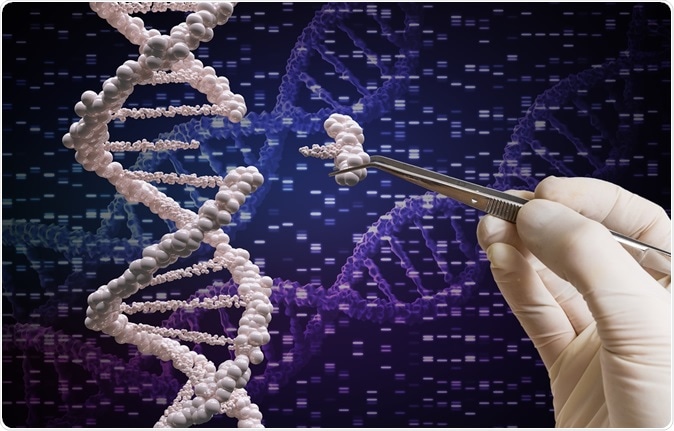David Liu, professor of chemistry and chemical biology at Harvard University is a pioneer of CRISPR-Cas9 gene-editing technology. He has now come up with two new upgrades for this gene editing tool that makes it better than before. These two tools are “cellular detective” and “sharp scissors”.
In the latest upgrades, Liu has come up with more. The first paper was published in the latest issue of the journal Science. It speaks of cellular detectives or CAMERA which is called a cell based “black box”. The second paper is published in the journal Nature and it speaks of xCas9, a gene-editor that is better and more sophisticated than the previous SpCas9.

Genetic manipulation and DNA modification concept. Image Credit: vchal / Shutterstock
Liu and a postdoc student Alexis Komer in 2016 developed CRISPR’s first base editor that could make changes in single letters in the genetic code. This was a breakthrough. This could help treat several genetic ailments and is already tried on plants or crops and on small animals such as mice and zebra fish. Genetically modified plants that could withstand climate and pests could be developed using this technology.
The cellular detectives that Liu created CAMERA 1 and 2 that would look at cellular diagnostic clues to find the genetic problem that could be responsible for the disease. CAMERA stands for “CRISPR-mediated analog multievent recording apparatus systems” and is developed by Liu and his postdoc Weixin Tang. For this the Cas9 protein would record all the cell data onto the DNA and piece together the information. It would look at cellular levels of how a stem cell can turn into all kinds of cells by differentiation. This would provide insights into cancers, stem cell therapies, aging as well as disease. There are speculations that this could look at a single cell in order to predict disease in future. However Liu warns that in reality, that could be far away now.
In the second study, Liu and his team worked on upgrading the existing CRISPR enzyme (spCas9). This enzyme depends upon specific DNA to locate the region where it would cut or edit. It can recognize only 1 out of 16 sites by scanning. Also the enzyme can hit “off-target” and miss the areas intended. In fact this was what was happening in recent studies where CRISPR was used to cure a disease and it led to several unwanted genetic changes. This new upgrade on the enzyme now addresses these problems. It is called extended-PAM Cas9s or xCas9s and is purported to be more precise and accurate. These can detect one in 4 DNA sites and are less likely to hit “off target” than earlier versions, says the team.
In yet another study published in Nature Communications, another technique has been described by Dr. Knut Woltjen and colleagues about a new gene editing method that can change or edit a single DNA base on the human genome. As of now, the two above studies have peaked the interest on CRISPR again and with these two upgrades and more to come, CRISPR gene editing may be heading in the right direction, speculate some experts.
References: